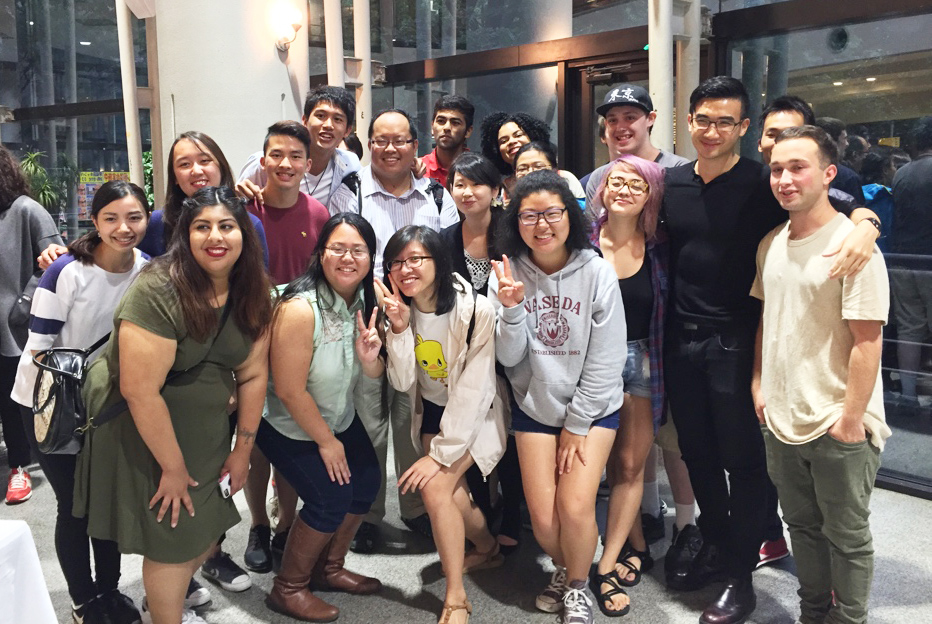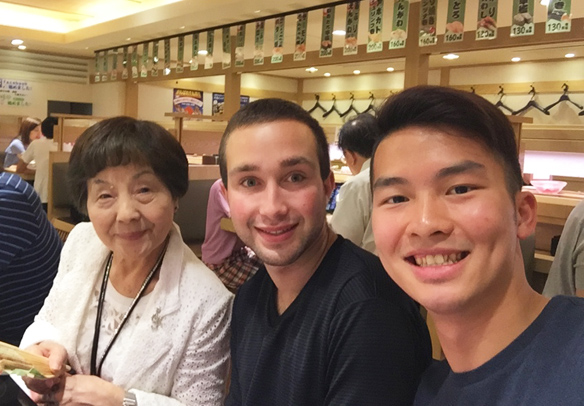Students Voice
2016

Koh Liang Wei
- Home Institute:
Fudan University, Shanghai
My first contact with Japan during my childhood was one that made me fall in love with the country and all it had to offer. My parents had brought me on a trip to Tokyo—one of the first trips that I could remember as a child and one that I would never forget; the numerous wars waged against the clock during rush hour, the vibrant lights and colourful signs glued haphazardly to the sides of buildings, the glow of dreams come true plastered on people’s faces at Tokyo Disneyland—these were what captivated my younger self. In the following years I would make three or four more trips to Japan, each time engaging in new activities and never going home disappointed. Even as my travels took me around the world to different countries and continents, there was always something about Japan that kept pulling me back.
Due to my late semester end date, it was always challenging to apply for summer programmes that started early in the summer. It was thus with excitement that I was finally able to make it into the Waseda programme this year, finishing my final exam in Shanghai just two nights before orientation started in Tokyo. I was fortunate to have a friend from my home university of Fudan join me on this programme, and this made planning a lot easier.
My experience started the moment the plane touched down in Tokyo. Despite being separated by only a two-hour flight, Shanghai and Tokyo were so culturally different. I remember how my friend was extremely impressed with the punctuality of the Japanese transport system, being able to plan our trips down to the very second. After checking in at the arranged accommodations for the month, my friend and I spent the evening exploring nearby Ikebukuro. Back in Singapore and even while studying in China, there were many aspects of Japanese culture that we always came into contact with, whether it was the Japanese language to the animated films that we always watched as kids, and even down to the stationery that we use (Pilot has always been one of my favourite). It was no surprise that we were extremely excited about everything around us.
The next day was the start of the Waseda Summer Session, beginning with the student interns guiding us to the campus from our respective accommodations. Ekoda had the largest group of students attending the summer programme and the journey to school was pleasantly peppered with conversations of everyone getting to know each other. Though we came from different parts of the world, there was always something we could talk about, and that was our love for Japan.
 Tanabata Festival in Tokyo!
Tanabata Festival in Tokyo!
I took two classes during the summer session. The first was “Controversies in Southeast Asia” by Professor Dabney and the second was “Japanese Popular Culture” by Professor Lim Tai Wei. In Professor Dabney’s class, we explored the concept of being a nation and a state, in the context of Japan, as well as how those ideas shaped and developed the behaviour of Japan as a country towards the way it deals with many of its modern day issues. Everyone was extremely open to different ideas and viewpoints and this was key in allowing us to have mature and deep conversations about a range of many different topics. It was supplemented by visits to the controversial Yasukuni Shrine where we explored the many facets of the delicate situation that it was in. Professor Dabney also provided a rigorous syllabus, trying to teach us as much as he could during the duration of the summer programme, whilst making use of the diversity of the students in the class to allow us as much time as possible to voice our opinions about the issues.
 With classmates from Professor Dabney’s Politics III Class
With classmates from Professor Dabney’s Politics III Class
Professor Lim’s class on Japanese popular culture was an extremely interesting one as well. It allowed us an in depth look into the Anime Comics and Games (ACG) industry, one whose products I myself have been a consumer of but never took the time to understand the process behind its development. From articles and books about Pokémon and Godzilla, Professor Lim provided us with many an interesting read—something that I as a finance student would normally not see as part of my reading list in school. Our field trips took us to Harajuku as well as Akihabara, the mecca of the ACG world. It was not difficult to see the amount of influence Japanese Popular Culture has had all over the world, with the entire class being really excited to see their beloved ACG characters. The trips allowed us to experience and explore the different subcultures that exist in Tokyo and understand how they all coexist together and contribute to the larger Japanese culture. With Prime Minister Shinzo Abe even dressing up as Mario during the closing ceremony of the Rio Olympics when the flag was passed on to Japan, we can see the significance of the role the ACG industry and its products play in shaping the Japanese identity.
 Professor Lim’s Culture III Class!
Professor Lim’s Culture III Class!
 Akihabara! The mecca of ACG fans
Akihabara! The mecca of ACG fans
On top of the lessons we had at Waseda, there were also the numerous trips that we went on within Japan. I was very fortunate to have been able to arrange my classes to be on just two days a week, lending me time to explore this beautiful country. With a highly efficient and connected railway system, it was unbelievably convenient to take many day trips to places just outside of Tokyo. Weekends at Yokohama and walking along the beach at Kamakura while exploring the many temples and shrines scattered around Japan allowed me the chance to be intrigued by the nuances that differentiated Japanese culture from so many others.
 Travelling at Kamakura
Travelling at Kamakura Wedding Ceremony at Meiji Shrine
Wedding Ceremony at Meiji Shrine
 Interacting with locals over lunch at Shibuya!
Interacting with locals over lunch at Shibuya!
One of the highlights of the programme was the trip to Nikko; over 150 students, student interns as well as staff spent a weekend at the beautiful town of Nikko. It was a chance for many of the students who had classes every day to take a break and learn about the history and culture of ancient Japan. Nikko was also home to the mausoleum of Tokugawa Ieyasu, one of the key figures in Japanese history. After a few hours of travelling by train and bus, we arrived at the scenic town and were treated to the beautiful and tranquil scenery of the mountains and rivers that surrounded Nikko. Many of us were more excited about the onsen at the hotel, rushing to take a dip the moment we settled down in our rooms. Come nightfall, the students—most of whom were dressed up in Yukatas—descended upon a grand Kaiseki dinner with tables upon tables stretched out across the dining hall. That the weekend was a wonderful opportunity for everyone to mingle and get to know each other, as well as for us to get to know the staff and all of the other student interns.
 Kaiseki Dinner in Nikko!
Kaiseki Dinner in Nikko! Onsen is a must!
Onsen is a must!
 Kegon Waterfall
Kegon Waterfall
All in all, my four weeks in Japan were nothing short of amazing. The Waseda Summer Programme offered me the opportunity to study under wonderful professors who were all extremely knowledgeable in their respective fields and to be able to interact with students from a host of different nations, cultures and walks of life. It was definitely sad to see everyone return home, but if there is something we learn from such programmes, it is that the world is smaller than we think and we will all definitely cross paths again. I myself hope to return to Japan in the near future and continue learning about the intricacies of Japanese culture.
 Closing Ceremony! No one wants to go home!
Closing Ceremony! No one wants to go home!
